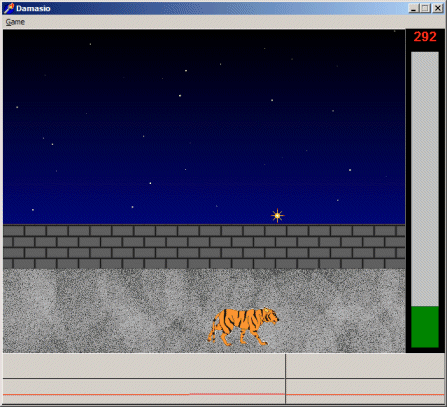
MAS630 Final Project by Vadim Gerasimov & Roy Rodenstein
5/11/1999
As we discussed in Spring '99 Affective Computing Damasio performed a “gambling experiment” to compare the skin conductivity of autistic and non-autistic subjects in a simulation of real-life decisions with uncertain outcomes and observe their actions' relation to their affective responses [Damasio 94].
The goal of our project was to verify Damasio’s results for a general pool of subjects in a modified experiment.
In our experiment subjects played a videogame that de-emphasizes the “gambling” aspect of the original experiment with playing cards.





Animated characters in the game are taken from the animated GIFs by Riad Dagher.
The game objective is to get the highest score. The game begins with the score indicator at 500 and ends after 12 minutes or when the score drops to 0. The score indicator consists of a numerical label and a bar that changes its height to indicate the current score.
The player moves a cartoon character at the bottom of the screen horizontally using the left and right arrow keys. The cartoon character captures identical stars falling from the top of the game field. The player can choose 4 different cartoon characters by pressing the spacebar. Each cartoon character gets a fixed number of points after capturing a star, but some stars explode instead, decreasing the score. The amount of points gained by capturing the star or lost when the star explodes depends on the type of character used to catch the star. If the character is too far from the star and cannot capture it the score does not change.
Two characters (the mouse and alligator) are “risky.” Those
two characters gain noticeably more points for catching a star than the other two,
“conservative,” characters (the pterodactyl and tiger), but lose so much that their
use can quickly lead to total score loss. The conservative characters do not gain
as much as risky ones, but lose very little. Players need to learn to choose conservative
characters to be successful in the game.
Each cartoon character is similar to a deck of cards in the Damasio experiment. The essential difference between the game and the Damasio experiment is time pressure added by the dynamism of the game and the end rule.
As in Damasio's original experiment we measured galvanic skin response of the subjects, using the sensor designed for the hand-held doctor for children project.
10 people (5 male, 5 female)
One subject left the experiment frustrated, four lost before the 12-minute time limit, and five subjects successfully made it through 12 minutes.
There was some variability in subject responses, about 20% of the time positive stars resulted in increased GSR and about 20% of the time negative stars failed to result in an increase in GSR. These anomalis sometimes were correlated with subjects who did not do well in the game. In general however, 80% of the time, the measurements were as expected.
Damasio’s results generally hold:
Here are graphs of the 10 recordings for the subjects.
Vertical dotted lines are star touch-downs
Colored horizontal bands indicate selected characters
Subject 1

Subject 2

Subject 3

Subject 4

Subject 5

Subject 6

Subject 7

Subject 8

Subject 9

Subject 10

What are the sources of the variability in subjects' responses?
What kind of 'Lab vs. Field' effects might be present in and affect these types of experiments?
Do the game's sound effects, a scream when a star explodes, matter?
What causes subjects' increased GSR response to negative events: innate competitiveness, their memory of previous negative affective event, or other factors?
Descartes' Error: Emotion, Reason and the Human Brain by A.R. Damasio. New York: Gosset/Putnam Press, 1994. Focus on Introduction (pp. xi-xix), "A Modern Phineas Gage" (pp. 34-39), "Emotions and Feelings" (pp. 131-141), "The Somatic Marker Hypothesis" (pp. 165-175 & 191-196), and "Testing the Somatic Marker Hypothesis" (pp. 205-222). (MAS630 Reader p.p 27-64).